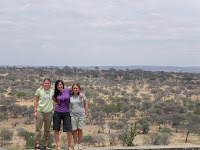(this was written yesterday but I am posting it now because the internet wasn't working last night)
We very frequently hear the phrase “be free” from Tanzanians. They say this as a way to welcome you to be comfortable and to encourage you to be yourself and to not hold back. This is a frequently used phrase, but unlike American phrases like “peace” or “chill out”, I don’t think that “be free” is ever said here without genuine interest. Today we did homestays throughout the village of Rhotia, and I was able to experience the reality of a Tanzanian home. Today’s experience helped me see that Tanzanians are truly free with their way of life – they work hard at what they do, carry themselves with confidence, and love their families. We’ve learned how friendly and welcoming Tanzanians are from the great staff we have here at the camp, but it was further emphasized as we were welcomed into stranger’s homes as part of their families.
This morning we were dropped off in pairs or groups of three at homes all around Rhotia. The mamas of the homes knew that we were coming and were told to treat us like their kids and to just go through a normal day. Leila and I spent the day with Irene and her five children – Ami, Lucy, Lucretia, Isabel, and Reggie. We also saw a lot of Irene’s sister, who lives next door, as well as other neighbors who were intrigued by the two mzungu (white people) who were attempting to act like Tanzanians. We spent the morning under the patient and helpful guidance of Irene and her oldest daughters – Ami and Lucy know a decent amount of English, but verbal communication throughout the day was definitely on the low side. That was ok though, because we learned English/Swahili from each other and got by pretty well saying “Naweza kusaidia?” - “how can I help?” - and “Sielewi” – “I don’t understand”. We helped wash the dishes, feed the cows and goats, shovel out the livestock shed, and made chai and lunch. Lunch was cabbage, chinese (a leafy green plant), and oogali (wheat flour added to hot water to make mush, that you then eat with your hands and use it as a spoon for veggies). We also walked to an area of acacia trees where we collected wood for cooking. Right before we left there was some time to hang around and we played hopscotch with the kids.
We all came back to camp with exciting stories and the urge to brag about our families. Everyone’s experiences were different and it was nice to hear how other homestays went. After dinner we had a discussion about the experience, as we were the first group of SFS students to do a homestay in Tanzania. We talked about what aspects of our day were the most eye-opening, etc, and this helped me wrap my mind around what we did today – it was a pretty intense/overwhelming experience! Right now I am most struck by a sense of deep respect and appreciation for my homestay family. They may live in mud huts and eat wheat flour porridge at every meal, but these facts are only notable to an outsider like me because I am used to something different. As the SFS director Professor Okello said to us tonight, if you don’t know what living with electricity is like, then you won’t be sad when you don’t have it. Your reality is what you make of it. Today we were lucky enough to spend a day as part of a Tanzanian family, and were able to realize the reality of how so many people in the world live. This was humbling, interesting, awkward, challenging, fun… In all, an experience that I will remember forever (sorry this part sounds so cheesy) and hope that I learn from for a long, long time.













